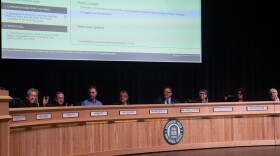Gasoline prices dropped like a rock last month but food prices shot up the most in nearly 50 years. Both have something to do with how we're living these days.
Overall, we're spending less and spending differently than we did just a few months ago. And that's affecting consumer prices for everything from pasta to auto insurance.
New inflation numbers out Tuesday from the Labor Department offer a window on how consumers are coping in the COVID-19 era.
Most of us aren't driving much, so gasoline prices tumbled 20.6% last month. The price of auto insurance also dropped in April, by 7.2% — more than any other month on record.
"With people driving less, that will inevitably mean fewer accidents," said Sean Kevelighan, CEO of the Insurance Information Institute. Auto insurers are offering discounts and refunds totaling more than $10 billion this year.
Kevelighan warns, however, that with fewer cars on the road, some people are driving faster. That means the accidents that do happen are often more costly.
"In fact, people are driving more recklessly at this time. And so that means we're having more injuries and greater damage," he said.
The new inflation report is filled with mixed messages like that. Overall, consumer prices were down 0.8% in April — the sharpest drop since the Great Recession in 2008. But food prices at the grocery store jumped 2.6% — the biggest jump since 1974, when double-digit inflation became a national concern.
The price of pasta and rice bubbled up 2.5% in April. Hamburger prices ground up 4.8%. And anyone who bought cookies had to lay out 5.1% more dough.
Americans had grown used to spending more than half their food budgets on meals eaten outside the home. But that changed abruptly when the coronavirus pandemic hit. Restaurants closed their doors and families were forced to cook for themselves.
"We saw an immediate, drastic decrease in expenditures away from home and an increase in the expenditures that we made at the grocery store," said David Ortega, a food economist at Michigan State University.
Ortega sees the change in his own habits. Instead of buying a prepared coffee at the campus bagel shop, he's making his own coffee at home with store-bought beans. He's also shopping for his wife and two-year-old daughter.
"Yep, I have to now go to the grocery store and make sure we have snacks and goldfish and crackers and just about everything that's going up in price," Ortega said.
There's little evidence that people's overall food consumption has increased (although the price of snacks jumped 3.8% last month). But where and what we're eating has shifted. And that's created some costly kinks in the supply chain.
Something similar famously happened with toilet paper, where household demand soared while office supplies went unused. Household paper prices jumped 4.5% last month.
There are a handful of other categories where prices rose — including hospital care (up 0.5%) and funerals (up 0.3%).
But while Americans are spending more on necessities like pasta and toilet paper, they're cutting back on everything else.
"Accordingly, prices are falling. Apparel was down on the month again. Airline fares are plummeting. Hotel prices [are] down," said Kathy Bostjancic, chief U.S. financial economist for Oxford Economics.
The price of used cars dropped 0.4% last month and could fall further if rental car companies decide they have too many cars and sell some of their surplus. There could be some bargains on the used car lot. But with millions of Americans suddenly out of work, it's not clear who will want to buy.
"Therein lies the issue," Bostjancic said. "And that's why you're seeing across the consumer spectrum deep discounting."
If you take out volatile food and gasoline prices, the cost of everything else fell 0.4% last month. Over the last year, these so-called "core prices" rose just 1.4%.
That suggests the government could afford to keep borrowing and spending money on emergency relief programs without fear of runaway prices.
"Inflation is the least of our worries right now," Bostjancic said.
Copyright 2020 NPR. To see more, visit https://www.npr.org.






